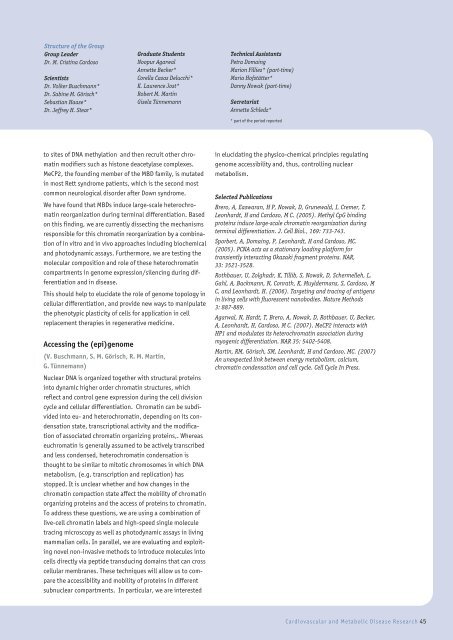of the Max - MDC
of the Max - MDC
of the Max - MDC
Create successful ePaper yourself
Turn your PDF publications into a flip-book with our unique Google optimized e-Paper software.
Structure <strong>of</strong> <strong>the</strong> Group<br />
Group Leader<br />
Dr. M. Cristina Cardoso<br />
Scientists<br />
Dr. Volker Buschmann*<br />
Dr. Sabine M. Görisch*<br />
Sebastian Haase*<br />
Dr. Jeffrey H. Stear*<br />
Graduate Students<br />
Noopur Agarwal<br />
Annette Becker*<br />
Corella Casas Delucchi*<br />
K. Laurence Jost*<br />
Robert M. Martin<br />
Gisela Tünnemann<br />
Technical Assistants<br />
Petra Domaing<br />
Marion Fillies* (part-time)<br />
Maria H<strong>of</strong>stätter*<br />
Danny Nowak (part-time)<br />
Secretariat<br />
Annette Schledz*<br />
* part <strong>of</strong> <strong>the</strong> period reported<br />
to sites <strong>of</strong> DNA methylation and <strong>the</strong>n recruit o<strong>the</strong>r chromatin<br />
modifiers such as histone deacetylase complexes.<br />
MeCP2, <strong>the</strong> founding member <strong>of</strong> <strong>the</strong> MBD family, is mutated<br />
in most Rett syndrome patients, which is <strong>the</strong> second most<br />
common neurological disorder after Down syndrome.<br />
We have found that MBDs induce large-scale heterochromatin<br />
reorganization during terminal differentiation. Based<br />
on this finding, we are currently dissecting <strong>the</strong> mechanisms<br />
responsible for this chromatin reorganization by a combination<br />
<strong>of</strong> in vitro and in vivo approaches including biochemical<br />
and photodynamic assays. Fur<strong>the</strong>rmore, we are testing <strong>the</strong><br />
molecular composition and role <strong>of</strong> <strong>the</strong>se heterochromatin<br />
compartments in genome expression/silencing during differentiation<br />
and in disease.<br />
This should help to elucidate <strong>the</strong> role <strong>of</strong> genome topology in<br />
cellular differentiation, and provide new ways to manipulate<br />
<strong>the</strong> phenotypic plasticity <strong>of</strong> cells for application in cell<br />
replacement <strong>the</strong>rapies in regenerative medicine.<br />
Accessing <strong>the</strong> (epi)genome<br />
(V. Buschmann, S. M. Görisch, R. M. Martin,<br />
G. Tünnemann)<br />
Nuclear DNA is organized toge<strong>the</strong>r with structural proteins<br />
into dynamic higher order chromatin structures, which<br />
reflect and control gene expression during <strong>the</strong> cell division<br />
cycle and cellular differentiation. Chromatin can be subdivided<br />
into eu- and heterochromatin, depending on its condensation<br />
state, transcriptional activity and <strong>the</strong> modification<br />
<strong>of</strong> associated chromatin organizing proteins,. Whereas<br />
euchromatin is generally assumed to be actively transcribed<br />
and less condensed, heterochromatin condensation is<br />
thought to be similar to mitotic chromosomes in which DNA<br />
metabolism, (e.g. transcription and replication) has<br />
stopped. It is unclear whe<strong>the</strong>r and how changes in <strong>the</strong><br />
chromatin compaction state affect <strong>the</strong> mobility <strong>of</strong> chromatin<br />
organizing proteins and <strong>the</strong> access <strong>of</strong> proteins to chromatin.<br />
To address <strong>the</strong>se questions, we are using a combination <strong>of</strong><br />
live-cell chromatin labels and high-speed single molecule<br />
tracing microscopy as well as photodynamic assays in living<br />
mammalian cells. In parallel, we are evaluating and exploiting<br />
novel non-invasive methods to introduce molecules into<br />
cells directly via peptide transducing domains that can cross<br />
cellular membranes. These techniques will allow us to compare<br />
<strong>the</strong> accessibility and mobility <strong>of</strong> proteins in different<br />
subnuclear compartments. In particular, we are interested<br />
in elucidating <strong>the</strong> physico-chemical principles regulating<br />
genome accessibility and, thus, controlling nuclear<br />
metabolism.<br />
Selected Publications<br />
Brero, A, Easwaran, H P, Nowak, D, Grunewald, I, Cremer, T,<br />
Leonhardt, H and Cardoso, M C. (2005). Methyl CpG binding<br />
proteins induce large-scale chromatin reorganization during<br />
terminal differentiation. J. Cell Biol., 169: 733-743.<br />
Sporbert, A, Domaing, P, Leonhardt, H and Cardoso, MC.<br />
(2005). PCNA acts as a stationary loading platform for<br />
transiently interacting Okazaki fragment proteins. NAR,<br />
33: 3521-3528.<br />
Rothbauer, U, Zolghadr, K, Tillib, S, Nowak, D, Schermelleh, L,<br />
Gahl, A, Backmann, N, Conrath, K, Muyldermans, S, Cardoso, M<br />
C, and Leonhardt, H. (2006). Targeting and tracing <strong>of</strong> antigens<br />
in living cells with fluorescent nanobodies. Nature Methods<br />
3: 887-889.<br />
Agarwal, N, Hardt, T, Brero, A, Nowak, D, Rothbauer, U, Becker,<br />
A, Leonhardt, H, Cardoso, M C. (2007). MeCP2 interacts with<br />
HP1 and modulates its heterochromatin association during<br />
myogenic differentiation. NAR 35: 5402-5408.<br />
Martin, RM, Görisch, SM, Leonhardt, H and Cardoso, MC. (2007)<br />
An unexpected link between energy metabolism, calcium,<br />
chromatin condensation and cell cycle. Cell Cycle In Press.<br />
Cardiovascular and Metabolic Disease Research 45
















